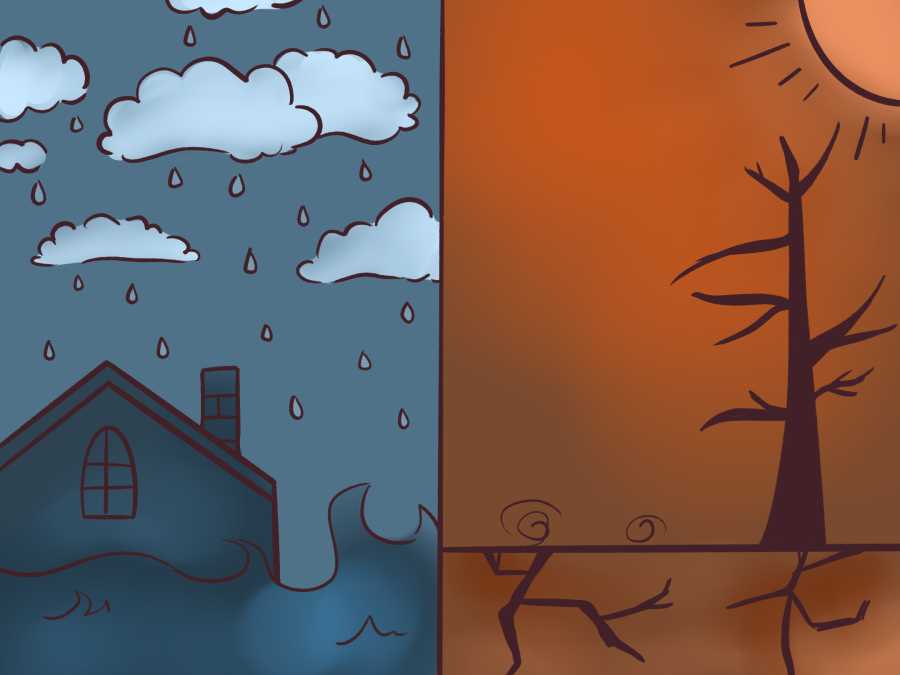When junior Austin Eng looked out his window one January morning, what he saw was not just some typical California rain. The storm beat harshly against his roof, and the water level crept up the sides of the house, threatening to damage it. He knew that his all-purpose jacket, the one that couldn’t withstand more than a drizzle without looking like it had gone through the washing machine, was not enough; he needed to innovate.
One quick search later, he emerged from his dad’s closet with a rain jacket from the ‘70s to borrow for the week.
“During rainy mornings, I always make sure to check the weather before anything so I can plan my day around breaks in the rain and how to dress accordingly,” Eng said.
As climate change alters global weather patterns, California has begun to shift away from its infamous stereotype of perfect weather. Consequently, Californian lifestyles are in the midst of a change.
Senior Jade Minskoff, co-president and founder of the Project Eco club, said California’s weather has become more extreme in the previous few years.
“The 10 warmest years on record in California occurred between 2012-2022,” Minskoff said. “This example of extreme weather means that heat waves will continue further.”
Beyond heat waves, AP Environmental Science teacher Nicole Loomis said climate change affects precipitation patterns on the West Coast.
“Climate change will affect, not necessarily the amount of precipitation, but the number of precipitation events and how much rain will be dumped in each event,” Loomis said.
Loomis also said the amount of precipitation that occurs each time it rains will likely increase, leading to potential flooding as the city saw in early January.
“(The increase in rainfall) could lead to increased levels of flooding, especially in low line areas which we do have some of in Palo Alto,” Loomis said.
Loomis said extreme weather conditions could be worsened by an increase in La Niño years, which increase precipitation and flooding, or La Niña years, which cause dry weather and drought.
Such extreme weather led students like Eng to take extra precautions, especially after school. Eng said he tries to plan his after-school time effectively when it’s raining so he can stay as dry as possible.
“Whether it be doing work in the library or grabbing a hot drink at Town and Country, I try to use the serenity of rainy weather to try and get some school finished somewhere inside,” Eng said. “I usually try to see if I can cover an extra shift at work just to be inside somewhere where I can be productive instead of running the risk of procrastinating at home.”
Yet, despite the large amounts of precipitation so far this winter, Loomis said the overall snowpack in the mountains is projected to decrease. The Bay Area relies on this snowpack for its water supply, meaning a decrease in the snowpack could lead to lifestyle changes related to water shortages
“There’s a lot of things people can do to collect their own water for their own supply,” Loomis said. “They can collect rain barrels or create water cisterns to get the extra water that ends up in the ocean.”
Because of the changes in weather patterns, Loomis said that people’s general lifestyle traditions are beginning to shift.
“For example, the ability to ski and snowboard will become more variable,” Loomis said. “The ability to swim at the coast may also become more variable whether the water is too cold or the surf is too rough.”
Minskoff also said climate change can cause rising desert temperatures.
“People who live in or visit deserts will eventually have to avoid them as the temperature is beginning to rise to numbers that break records,” Minskoff said. “Of course, most deserts in California that reach these temperatures are not inhabited, but populated deserts may put some people at risk.”
And while Minskoff said she has yet to experience much personal change related to climate change, she knows many people have lost a lot as a result.
“I have just noticed the more extreme heat over the summers,” Minkoff said. “Due to the rain that we received this year, I did notice I went outside a lot less than normal, although this is nothing in comparison to individuals who have had much more extreme lifestyle changes due to extreme weather.”
For residents in the Bay Area, Loomis said that those who are living in low-lying areas or on the coast have experienced some detrimental effects to their lifestyle.“Certainly, there are landslides, things are damaged on Route 1, and there’s a lot of low-lying areas along the Caltrain in Belmont and San Carlos that got flooded,” Loomis said. “Some people lost their homes just from these floods in January.”
Loomis said in the end that people should be cautious and forward-thinking about how climate change will affect them.
Loomis said, “One way to adapt is to really think about where you want to live and make sure that you are a good distance above sea level.”



